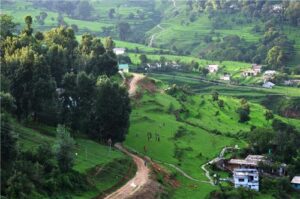Champawat Distance


Champawat Distance, a quaint town in the Kumaon region of Uttarakhand, India, is a hidden gem with a rich history, natural beauty, and cultural heritage. Nestled in the Himalayan foothills, Champawat is surrounded by lush greenery, rolling hills, and pristine rivers, creating a serene ambiance that captivates visitors. The town holds historical significance as the ancient capital of the Chand dynasty, and remnants of its past glory can be explored in the form of temples and historical structures.
Champawat Distance is renowned for its ancient temples, including the Baleshwar Temple dedicated to Lord Shiva. The intricate architecture and religious significance of these temples attract both pilgrims and enthusiasts interested in the region’s cultural heritage. The town’s proximity to the Indo-Nepal border adds a unique dimension to its identity, contributing to a blend of cultures and traditions.
The tranquil landscapes surrounding Champawat Distance provide a peaceful retreat for those seeking a respite from the hustle and bustle of city life. The Kali River flows through the region, offering opportunities for scenic walks and moments of quiet reflection along its banks. For adventure seekers, Champawat serves as a base for exploring nearby trekking trails, including the revered Purnagiri Temple trek.

Champawat’s Distance cultural vibrancy comes alive during local festivals and fairs, where traditional music, dance, and rituals showcase the town’s heritage. The region’s warm hospitality is evident in the welcoming nature of its residents, creating an inviting atmosphere for visitors.
As Champawat Distance retains its off-the-beaten-path charm, it stands as a destination that allows travelers to immerse themselves in a bygone era while experiencing the natural beauty and cultural richness of the Kumaon region. Whether exploring historical sites, trekking through scenic landscapes, or simply savoring the tranquility of the Himalayan foothills, Champawat offers a unique and authentic Himalayan experience.
Champawat’s Distance allure extends beyond its historical and cultural facets, embracing the enchanting natural landscapes that surround the town. The region is dotted with terraced fields, orchards, and forests, providing a picturesque backdrop against the backdrop of the Himalayan peaks. The undulating terrain offers panoramic views of snow-capped mountains, making Champawat a haven for nature lovers and photographers.

The nearby Abbott Mount, perched at an elevation, offers breathtaking vistas of the surrounding hills and the distant snow-capped Himalayas. This tranquil location, adorned with colonial-era cottages and lush gardens, provides a perfect escape for those seeking solitude and rejuvenation.
Champawat Distance also serves as a gateway to the Pancheshwar Dam, a major hydroelectric project situated at the confluence of the Kali and Saryu rivers. The dam not only contributes to the region’s energy needs but also creates a reservoir that adds to the scenic beauty of the landscape.
The town’s cultural identity is further enriched by its traditional arts and crafts. Local artisans create intricate wood carvings, pottery, and woolen textiles, showcasing the craftsmanship that has been passed down through generations.
Champawat’s proximity to the Binsar Wildlife Sanctuary presents opportunities for wildlife enthusiasts to explore the diverse flora and fauna of the region. The sanctuary is home to a variety of wildlife, including leopard, barking deer, and numerous bird species, making it an ideal destination for nature and wildlife enthusiasts.
In recent years, efforts have been made to promote sustainable tourism in Champawat, emphasizing the preservation of its natural beauty and cultural heritage. As visitors explore the town and its surroundings, they not only witness the timeless charm of Champawat but also become part of the ongoing narrative of responsible tourism in the Kumaon region.

Champawat’s cultural vibrancy is evident in its local festivals and fairs, which provide a window into the traditional customs and celebrations of the region. The Navratri festival, dedicated to the goddess Durga, is observed with fervor, featuring colorful processions, folk dances, and religious rituals. During this time, Champawat becomes a lively hub of cultural activity, drawing both locals and tourists to partake in the festive spirit.
For those interested in spiritual exploration, the region offers opportunities for meditation and yoga amidst the serene surroundings. Champawat’s tranquil environment, complemented by the gentle flow of rivers and the soothing rustle of the surrounding forests, creates an ideal setting for those seeking inner peace and self-discovery.
The town’s historical landmarks, such as the Golu Devta Temple, contribute to its mystique. Golu Devta, considered the deity of justice, attracts devotees who come to seek divine intervention and participate in a unique ritual of tying letters to the temple premises, detailing their grievances and seeking resolutions.

Champawat’s role in Uttarakhand’s cultural and historical narrative is preserved in its museums. The Nagar Kot Archaeological Museum showcases artifacts and sculptures from the region’s rich past, providing insights into the art and architecture of ancient Champawat.
As tourism in Champawat remains relatively undiscovered, the town retains an authentic and unspoiled charm, offering an opportunity for travelers to experience the Himalayan culture in its purest form. The warmth of the local communities, the ancient echoes of its temples, and the untouched beauty of its landscapes make Champawat a destination that beckons those seeking an offbeat and immersive Himalayan experience.
1. Why is Champawat famous?
- Historical Significance: Champawat holds significant historical importance as it was once the capital of the Chand rulers, who ruled over the Kumaon region of Uttarakhand. The district has ancient temples, forts, and ruins that reflect its rich cultural heritage and historical legacy.
- Natural Beauty: Champawat is blessed with breathtaking natural beauty, with lush green valleys, dense forests, and panoramic views of the Himalayan mountains. The district is dotted with scenic spots, including waterfalls, rivers, and trekking trails, making it a paradise for nature lovers and adventure enthusiasts.
- Temples and Religious Sites: Champawat is home to several temples and religious sites that attract devotees and pilgrims from far and wide. The Baleshwar Temple, dedicated to Lord Shiva, is a prominent religious landmark in Champawat, known for its architectural grandeur and spiritual significance.
- Cultural Heritage: The district has a rich cultural heritage, with diverse communities and traditions coexisting harmoniously. Champawat celebrates various festivals and cultural events throughout the year, showcasing its cultural vibrancy and diversity.
- Adventure Tourism: Champawat offers ample opportunities for adventure tourism, including trekking, camping, wildlife safaris, and river rafting. The district is home to wildlife sanctuaries and reserves, such as the Binsar Wildlife Sanctuary and the Askot Wildlife Sanctuary, where visitors can explore the region’s biodiversity and natural habitats.
- Handicrafts and Artisans: Champawat is known for its traditional handicrafts and artisanal products, including wood carvings, woolen shawls, and handmade textiles. The district’s skilled artisans preserve age-old crafts and techniques, contributing to its cultural heritage and economic livelihood.
2. Why is Champawat called Kali Kumaon?
- Kali Temple: Champawat is home to the Champawat Kali Temple, dedicated to the Hindu goddess Kali. This temple is considered one of the oldest Kali temples in the region and holds significant religious importance for devotees. The presence of this temple dedicated to Goddess Kali has led to Champawat being associated with the deity.
- Cultural Significance: The worship of Goddess Kali has deep roots in Hinduism and is particularly prevalent in the Kumaon region of Uttarakhand. Kali is revered as a powerful and fierce deity, often depicted with multiple arms, carrying weapons, and standing atop a demon. The worship of Kali is associated with protection, strength, and the destruction of evil forces.
- Historical Legacy: Champawat’s historical significance as the capital of the Chand rulers, who were devout followers of Goddess Kali, further strengthens its association with the deity. The Chand rulers patronized the construction of temples dedicated to Kali, and their devotion to the goddess left a lasting imprint on the region’s cultural and religious landscape.
- Local Traditions and Festivals: The worship of Goddess Kali is an integral part of the cultural traditions and festivals celebrated in Champawat and the surrounding areas. Various rituals, prayers, and festivals dedicated to Kali are observed with fervor and devotion by the local communities, further reinforcing Champawat’s identity as “Kali Kumaon.”

